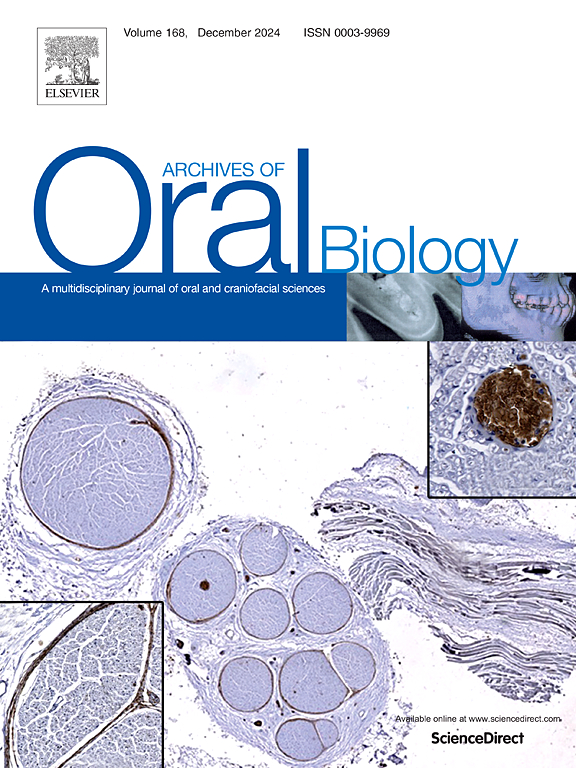活性炭和含氟牙膏在口腔生物膜中的抗菌作用。
IF 2.1
4区 医学
Q2 DENTISTRY, ORAL SURGERY & MEDICINE
引用次数: 0
摘要
目的:含碳牙膏因其美白功效而越来越受欢迎,但有关抗菌效果的数据有限。本研究比较了木炭牙膏与含氟化钠(NaF)、氟化亚锡(SnF 2)或单氟磷酸钠(NaMFP)的非木炭牙膏对多种口腔生物膜的抗菌效果。方法:在羟基磷灰石盘上培养变形链球菌、哥氏链球菌和血链球菌的生物膜,用6种牙液(3种木炭牙液,3种非木炭牙液)或对照组(生理盐水和0.12 %氯己定,CHX)处理60 s。以CFU/mL评价抗菌效果;(n = 9/组)和qPCR (n = 3/组)。对于氟化物型分析,将木炭和非木炭牙膏组合使用(CFU n = 18/型;qPCR n = 6/型)。使用事后检验的单因素方差分析比较各组间减少的百分比。结果:NaF牙膏的整体抑菌活性最高(降低46.8% %),NaMFP次之(降低34.9% %),SnF 2的总体抑菌活性最低(≤5.7 %)。炭包合不提高疗效,并略微降低NaF活性。物种特异性反应各不相同:NaF消除了gordonii,并显著减少了S. mutans和S. sanguinis。炭包埋没有显著改变物种水平的生存能力。qPCR支持CFU趋势,但组间差异有限。总的来说,氟化物类型——而不是木炭——主要决定功效(NaF > NaMFP > SnF2)。结论:氟化物类型对抗菌效果的影响大于木炭。NaF效果最好,SnF效果最差。木炭没有任何好处,可能会略微降低NaF的性能。氟化物的选择比木炭添加剂在预防龋齿方面更为关键。本文章由计算机程序翻译,如有差异,请以英文原文为准。
Antibacterial effects of charcoal and fluoride dentifrices in oral biofilms
Objectives
Charcoal-containing dentifrices are increasingly popular for their whitening claims, but data on antimicrobial effects are limited. This study compared the antibacterial efficacy of charcoal dentifrices versus non-charcoal dentifrices containing sodium fluoride (NaF), stannous fluoride (SnF₂), or sodium monofluorophosphate (NaMFP) against multi-species oral biofilms.
Methods
Biofilms of Streptococcus mutans, S. gordonii, and S. sanguinis were grown on hydroxyapatite discs and treated for 60 s with 6 dentifrice slurries (3 charcoal, 3 non-charcoal dentifrices) or controls (saline and 0.12 % chlorhexidine, CHX). Antibacterial effects were assessed by CFU/mL; (n = 9/group) and qPCR (n = 3/group). For fluoride-type analyses, charcoal and non-charcoal dentifrices were combined (CFU n = 18/type; qPCR n = 6/type). Percent reduction was compared across groups using one-way ANOVA with post-hoc tests.
Results
NaF dentifrices exhibited the greatest overall antibacterial activity (46.8 % reduction), followed by NaMFP (34.9 %), while SnF₂ showed minimal effect (≤ 5.7 %). Charcoal inclusion did not enhance efficacy and slightly reduced NaF activity. Species-specific responses varied: NaF eliminated S. gordonii, and significantly reduced S. mutans and S. sanguinis. Charcoal inclusion did not significantly alter species-level viability. qPCR supported CFU trends but showed limited between-group differences. Overall, fluoride type – not charcoal – primarily determined efficacy (NaF > NaMFP > SnF2).
Conclusions
Fluoride type had a greater impact on antibacterial efficacy than charcoal. NaF was most effective, while SnF₂ least. Charcoal offered no benefit and may slightly diminish NaF performance. Fluoride choice is more critical than charcoal additives for caries prevention.
求助全文
通过发布文献求助,成功后即可免费获取论文全文。
去求助
来源期刊

Archives of oral biology
医学-牙科与口腔外科
CiteScore
5.10
自引率
3.30%
发文量
177
审稿时长
26 days
期刊介绍:
Archives of Oral Biology is an international journal which aims to publish papers of the highest scientific quality in the oral and craniofacial sciences. The journal is particularly interested in research which advances knowledge in the mechanisms of craniofacial development and disease, including:
Cell and molecular biology
Molecular genetics
Immunology
Pathogenesis
Cellular microbiology
Embryology
Syndromology
Forensic dentistry
 求助内容:
求助内容: 应助结果提醒方式:
应助结果提醒方式:


